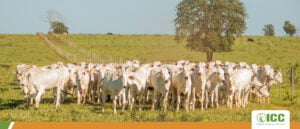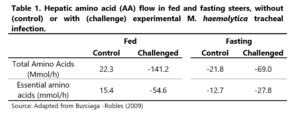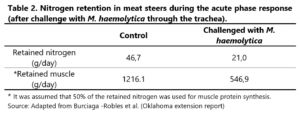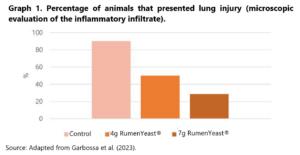Relationship between infectious diseases and animal performance

Find out what tools can keep your herd in high immune status and avoid paying tolls that can hurt animal growth and business profitability
Diseases reduce animal growth and cause significant economic losses in livestock systems, especially subclinical conditions, as they go unnoticed. Subclinical forms of acidosis and bovine respiratory complex (CBC) are the diseases that most affect beef farming.
In this text, we would like to expand the understanding of the relationship between disease and animal growth, discussing some mechanisms that explain how respiratory tract infections reduce growth and what nutritional tools we can use to mitigate this problem.
The growth of infectious agents in the respiratory tract, with emphasis on M. haemolytica, usually occurs because of suppression of host defense mechanisms, i.e., a reduction in immune status, commonly associated with periods of stress, fasting, temperature variation, transport, viral infections, etc.
We can think of weight gain as the end of a journey with a starting point in dietary intake and an end point in the use of nutrients for muscle synthesis (meat). However, nutrients travel down a toll road and payment of each toll is made by retaining a fraction of the nutrients.
In the animal organism an important toll is the liver. Burciaga-Robles (2009) determined the effect of pneumonia on the price charged for this toll, or rather, determined how CRB affects the net flow of amino acids through the liver in fed or fasting animals, in the acute inflammatory response phase after the challenge. (infected animals) with M. haemolytica (Table 1)

The net flux of amino acids can be defined by the formula:
Net flow = flow of AA out of the liver — flow of AA into the liver.
Where AA = amino acids.
- Between the two groups of fed animals, the liver became a net user of AA (began to take toll) in the challenged group. In other words, in animals exposed to haemolytica, the amino acid output from the liver was less than the input (negative value).
- In the case of the two groups of fasting animals, the liver, which was already a net user (toll taking) in the control group, further increased its demand for amino acids (increased toll price) in the challenged group.
In summary, in the challenged animals, after hepatic processing of amino acids, a smaller fraction was available to produce animal products: milk, meat, etc.
Growth loss during the acute phase of response (the animal’s response to the infectious agent/challenge) can be noticed when we assess the amount of nitrogen retained in the animals’ bodies (Burciaga-Robles et al., Oklahoma extension report). The challenge reduced nitrogen retention by 54%. If we assume that 50% of the retained nitrogen was used for muscle protein synthesis, we could infer that the animals in the challenged group gained 546 g/day of muscle (meat), while in the control group the gain was 1216 g/day (Table 2).

The reduction in the net flow of amino acids through the liver, associated with reduced growth, suggests that the ingested protein was used for activities other than growth, for example, to support the acute phase immune response, that is, to support the animal’s response seeking to restore health against the disease-causing agent, M. haemolytica (challenge).
To reduce respiratory problems in addition to management strategies such as reduction of environmental dust, humidity beds, stress etc., there are already food additives on the market that can improve the immune status of the animal, allowing them to overcome this and other infectious challenges more quickly and efficiently.
By applying these additives, it is possible to reduce morbidity and costs related to some infectious processes.
These additives include autolyzed yeasts from the sugarcane ethanol industry. This type of yeast contains, among other active ingredients, high levels of ß-1,3 and 1,6 glucans, important immunonutrients (De Marco Castro, et al., 2021). The improvement observed in health parameters, in vivo tests with beef cattle, indicates that the ß-glucans of RumenYeast® reach the intestinal environment exerting their known immunomodulatory effect. For example, Garbossa et al. (2023) supplemented fattening steers with autolyzed yeast from the sugarcane ethanol industry (RumenYeast®) in daily doses of: 0g (control), 4g and 7g and observed a reduction of up to 68% in lung lesions (Graph 1). Associated with this improvement in respiratory tract health, animals supplemented with RumenYeast® showed 4.5% greater daily weight gain during the 105 days in feedlots (Pontarolo et al., 2021).

As we saw earlier, reducing the processes of lung inflammation reduces the toll price allowing a greater daily weight gain.
However, it should be noted that this effect cannot be attributed solely to the reduction of inflammatory processes in the lung, since RumenYeast® also can improve rumen parameters (pH, digestion, etc.) and decrease the levels of markers linked to the general inflammatory state (Días, et al., 2018a,2018b).
Infectious processes such as those associated with CRB, diarrhea, mastitis, etc., are realities present in all contemporary animal production systems. These processes initiate an acute phase immune response that seeks to restore the health status of the animals. However, as we discussed, although the acute phase response is necessary, it has a cost and consumes nutrients that could be used in channel deposition. In this regard, we must always keep production animals with a high immune status, so that animals respond quickly and efficiently to infectious challenges. In this way, when challenged, animals will regain their full health more quickly, avoiding nutrient losses associated with the acute phase response.
Autolyzed sugarcane yeast (RumenYeast®), through its immunonutrients, has allowed a faster response of the animal’s defense system, which explains, in part, the increases in growth (meat and milk production) between 3% and 6%, commonly observed when this additive is applied to livestock diets.
By: William Reis, PhD. Technical and R&D Specialist (Ruminants) at ICC Brazil.
Posted in 24 October of 2023


